 The Challenge: To prepare three meals a day for the next five days on a budget of no more than £15.
The Challenge: To prepare three meals a day for the next five days on a budget of no more than £15.
Hi, I am Adam, and I normally spend around £30 on groceries a week. This challenge meant that I had to reduce that to half. Probably the best piece of advice to start with is planning. A meal plan with a shopping list makes the whole process much more efficient. It minimises the number of times you need to go shopping, reduces the time you spend there, prevents you from buying unnecessary things, and helps you save money. You will also not have any leftovers that you would have to throw away.

Every Sunday, therefore, I try to plan my weekly meal plan. With this challenge, it was basically essential.
Once the plan was done, I wrote down things I needed. For the list, I use the NOSH book app. I genuinely recommend buying a cookbook as it really helps with ideas on what to cook. NOSH is also very student-friendly, and it comes with an app in which you can browse recipes and automatically add everything to a shopping list. The ‘Broke but hungry’ chapter of this book with affordable recipes was particularly useful for this challenge.
With the shopping list done, it was time to head to Sainsbury’s to do the shopping. My tip here is to use their Smart Shopping app that not only makes the shopping more efficient because you can scan as you go with your phone, but it also helps you to save money as you get some personalised discounts with your Nectar account.
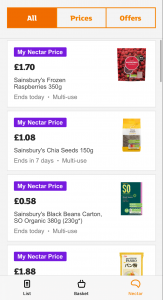
When shopping, my tip would be to look for reduced stuff. Things like bread that can be frozen can often come at a fraction of the price. Another tip is to look at the bottom shelf for cheaper brands or own-label products. Marketers often put the products that are premium or have the highest margin on the eye level, leaving the more affordable brands at the bottom. Also, fresh vegetables can be quite expensive so look out for the Imperfectly tasty series that is more affordable.

<-This is what my shopping looked like at the end.
Note: As I was not able to use any things I had at home, I had to include the cost of things like oil, salt, curry powder, pasta and rice – things that last for longer once you buy them so shall I continue the challenge the next week, I could buy more different products.
With the shopping done, it was time to start cooking.
Day 1
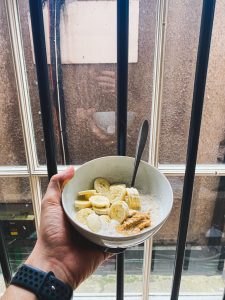
Breakfast
SUPER QUICK PORRIDGE
Ingredients: Milk, Oats, Peanut butter, Banana
1. Combine some milk and oats, and simmer until it thickens. Remove from heat.
2. Add sliced banana, a spoon or two of peanut butter, and your breakfast is ready. You could use plant-based milk too!
Lunch
POTATO HASH
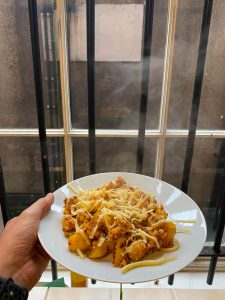
Ingredients: 4 medium diced potatoes, 400g baked beans, Oil, Cheddar cheese, Ketchup (optional)
1. Put the potatoes in a pan of boiling water and simmer for 8 minutes. Drain, return to the pan and squash them a little with a fork. Do not mash them.
2. Stir in the beans.
3. Heat some oil in a frying pan and tip the mixture in. Don’t stir, allow it to dry and brown on the bottom. Once browned, using a spatula, stir all the browned bits up from the bottom, leave again to allow the rest to brown. Stir in the browned bits again.
4. Serve with some cheese on top and optionally add ketchup.
Dinner

FRIED RICE
Ingredients: a mug of rice, 4 eggs, 3 chopped spring onions, half of the pepper, chopped carrot, soya sauce
- Cook rice and let it cool.
- In a wok, heat some oil and on high heat stir-fry 2 spring onions, carrot, and pepper for 2 minutes.
- Add rice and stir-fry for another minute.
- In the meantime, fry eggs in a separate pan.
- Add soya sauce to the wok and stir-fry for 1 minute.
- Serve the rice and put the fried eggs on the top. Add some finely chopped onion on top. You can add some more soya sauce if needed.
Day 2:
Breakfast:
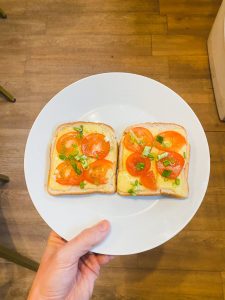 CHEESE ON TOAST WITH TOMATO
CHEESE ON TOAST WITH TOMATO
- Put some slices of cheese on to bread and put in the oven.
- Allow to melt
- Add some fresh tomato and spring onion on top
Lunch:
POTATO HASH LEFTOVERS
Dinner:
FRIED RICE LEFTOVERS
Day 3:
Breakfast:
SUPER QUICK PORRIDGE
Lunch:
 CHANNA DHAL
CHANNA DHAL
Ingredients: Oil, 1 onion, finely chopped, 2 cloves garlic, finely chopped, Freshly grated ginger, ½ teaspoon, Curry powder, ½ x 400g can tomatoes, 2 tablespoons coconut milk, 400 g tin of chickpeas
- Heat the oil in a frying pan and fry the onions and garlic until they begin to brown. Stir frequently. Once brown, add the ginger and curry powder. Cook for 1 minute.
- Add the tomatoes, coconut milk and chickpeas. Season well with salt and pepper. Cook for about 5 minutes until the mixture begins to thicken.
Note: the leftover coconut milk can be used to make some sauce
Dinner:
CHANNA DHAL LEFTOVERS
Day 4:
 Breakfast:
Breakfast:
TOAST, CHEESE, TOMATO
This was the same as before, but I added two fried eggs.
Lunch:
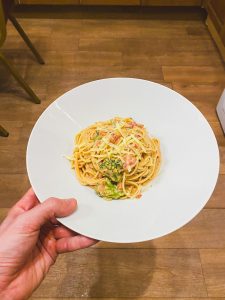 CREAM CHEESE PASTA
CREAM CHEESE PASTA
Ingredients: 300g of spaghetti, Cream cheese, ½ of 400g tin of tomatoes, Broccoli, Cheese, grated
- Put the pasta on the cook.
- Boil broccoli until soft.
- In a saucepan on medium heat, combine the cream cheese, tomatoes, and cheese. Season with salt. Simmer until it thickens and combines.
- Add broccoli to the sauce and squash it a little.
- Add pasta and toss.
- Serve with some grated cheese on top.
Dinner:
CHANNA DHAL LEFTOVERS
Day 5:
Breakfast:
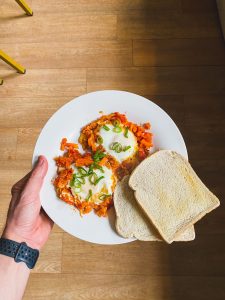 SHAKSHUKA
SHAKSHUKA
Ingredients: Oil, Onion, chopped, ½ of 400g tin tomatoes, 1 garlic clove, finely chopped, 2 eggs, ½ of pepper, chopped
- Heat oil in a frying pan put onion, pepper and garlic and cook until soft.
- Add tomatoes and stir until thickens.
- With a large spoon, make 2 dips in the sauce and crack an egg into each one.
- Put on a lid and cook for 6-8 mins on low heat.
- Serve with a toast.
Lunch:
CREAM CHEESE PASTA LEFTOVERS
Dinner:
CREAM CHEESE PASTA LEFTOVERS
Conclusion
I was positively surprised how much I could buy and how many dishes I could make while sticking to £15. Most importantly, at the end of the week, I was left with almost no leftovers which was the idea of the whole project. Utilising the things we have and not throwing out anything.
Written by Adam Balazi, Student Champion
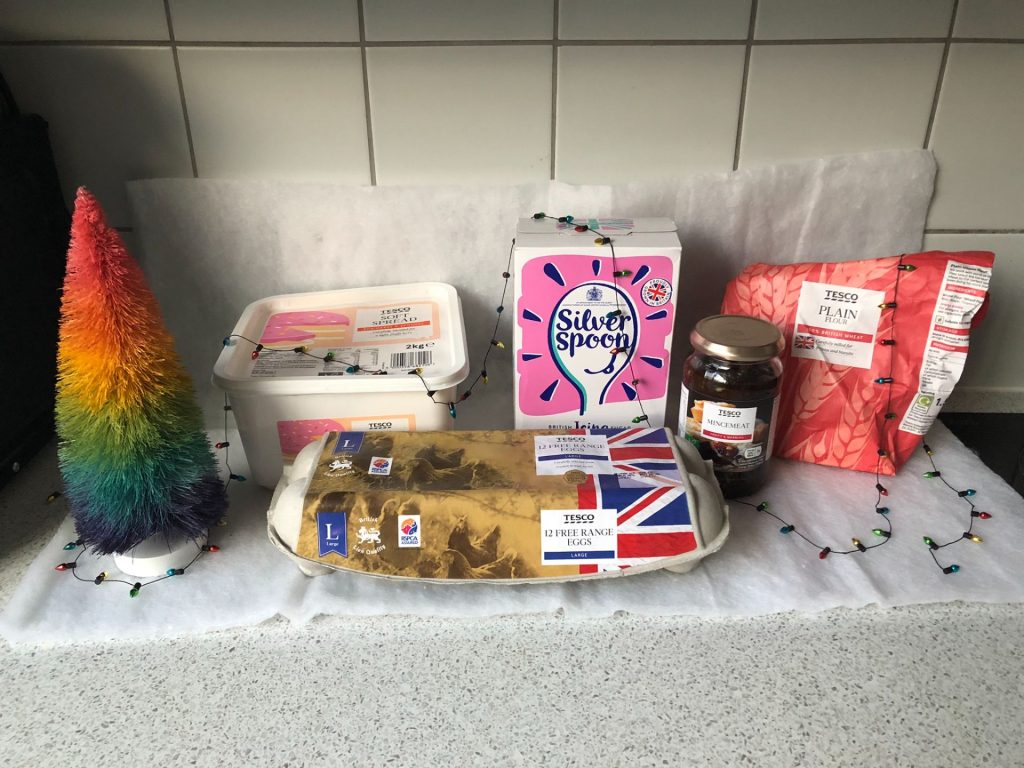








 CHEESE ON TOAST WITH TOMATO
CHEESE ON TOAST WITH TOMATO CHANNA DHAL
CHANNA DHAL Breakfast:
Breakfast: CREAM CHEESE PASTA
CREAM CHEESE PASTA SHAKSHUKA
SHAKSHUKA